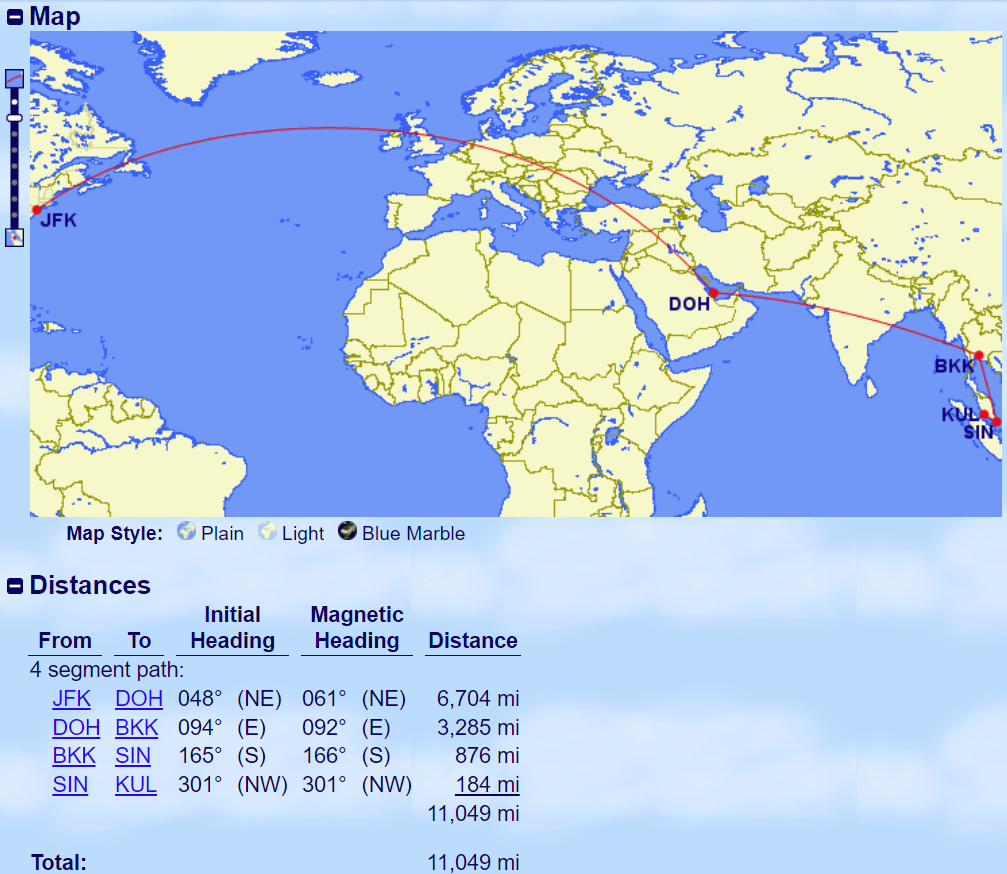Alaska Airlines is introducing new, distance-based award charts in March. Covering this change, I noted that:
- Long haul awards involving connections will often get more expensive. You’re going to pay more for premium cabin Cathay Pacific and Qantas trips.
- But their newer, higher-priced partners get cheaper. For instance expect to pay as much as 30% less for business class on El Al. And non-stop awards in a majority of cases will get cheaper.
- Short distance awards in Asia and the Mideast are an amazing deal at just 15,000 miles each way in business class (e.g. Tokyo to Beijing or Shanghai, Bangkok to Hong Kong, etc. – and you can even do a stopover in the price)
And I wrote that the best value from distance-based charts often comes from maxing out distance, for instance flying West Coast – Tokyo to stay within a distance band and avoid going over… but also sometimes by booking two awards to get the pricing of two shorter distance bands rather than the combined higher-distance band. I’d like to explain this a little bit more.
Here’s the award chart that covers flights between the U.S. and Asia. You’ll notice that there’s a big price increase for one-way trips over 10,000 miles.
- Itineraries 7,000 – 10,000 miles one way cost 85,000 miles in business class
- Itineraries over 10,000 miles one way cost 130,000 miles in business class, or 45,000 miles more

So New York – Doha – Bangkok at 9,989 miles costs 85,000 miles, while New York – Doha – Singapore at 10,561 miles costs 130,000 miles in business class.
What can you do? If you want to fly New York to Singapore, consider:
- New York to Bangkok on one ticket (85,000 miles)
- Bangkok to Singapore on a second ticket (15,000 miles)
- Total cost is 100,000 for business class, a savings of 30,000 miles

Singapore
Better yet, since Alaska Airlines allows stopovers this would allow you to stop over in Doha and Bangkok.
In fact, say you wanted to go to Singapore … but you could even call Singapore a stopover, and add another flight say to Kuala Lumpur (keeping Bangkok to your destination via Singapore, in this case Kuala Lumpur, under 1,500 miles). So for 100,000 miles you visit 4 cities instead of 2 and save 30,000 miles in the process.
- New York JFK – Doha (stop)
- Doha – Bangkok (destination, end ticket one)
- Bangkok – Singapore (stop)
- Singapore – Kuala Lumpur (destination, end ticket two)

This will all be possible with the new chart in March. The first ticket can be done with Qatar Airways, and the second with Singapore Airlines.
Later in 2024 Alaska will allow you to mix and match partners in a single one way ticket and that will open up possibilities even more.
You want to be looking for routes that maximize one distance band and then let you use a cheaper band instead of booking the entire one way as a single award. This can both save you miles and get you two extra stops for cities to visit. Instead of free stopovers, these are negative price stopovers.
Frequent Miler covers some additional trips that simply drop in price using the new charts.
- Northeast North America – Europe one way in business class goes down to 45,000 miles each way (West Coast 55,000 miles). Iberia awards were 75,000 miles, so the reduction to 45,000 miles is huge.
- Royal Air Maroc from the East Coast to Casablanca drops from 100,000 miles in business class to 55,000 miles.
- Generally El Al, Royal Jordanian, and Qatar Airways flights between the U.S. and Mideast get less expensive.
- As I noted in my original post, Icelandair business class will price as premium economy, dropping from 55,000 miles one way to 30,000 or 35,000 depending on the route. That makes it a much better value, obviously.
- Air Tahiti Nui from Los Angeles to Papeete (stopover in Tahiti if you wish) to New Zealand drops to 75,000 miles.

Bora Bora as a free stopover, yes please
There are sweet spots that will disappear from the old Alaska Airlines award chart, but there’s plenty of upside as well. Crucially, they are revamping the program while still leaving it with incredible value. And going through partner awards, which are negotiated bilaterally, is too cumbersome to do regularly. So hopefully this unified approach to partner awards should last for quite awhile even as programs around them devalue.


Valid arguments, particularly if Alaska will automatically price at the lower cost on a multi-leg itinerary. I’m still not sold that this is largely a good thing but I may have been mistaken in seeing a lot more bad than good. Availability at the lowest rate, complex routing prices that are not currently allowed, and actually seeing the promised multi-partner awards will count for a lot. I feel less bad than previously though, so thanks.
Alaska’s changes might not be so bad after all. Last month I booked Business/First LATAM IAH-SEA-LAX-SCL (stopovers in both SEA and LAC) for 45K Alaskan miles. These are lie flats on a Dreamliner. Grest value.
By far, my favorite part of this devaluation is Alaska telling IcelandAir that their “business class” isn’t business class-y enough to count as anything above Premium Economy.
This is a devaluation but the distance awards should be fun. Award availability is DRY ..DRY to the bone unless you want to fly Starlux for a 235,000 miles ( an i am sure they will restrict awards big time when the price goes down). QR sometimes has decent but I am not going through the middle east to go to Asia.
Is it confirmed that stopovers will be available intra Asia? I though Alaska had removed stopovers for Asia-Asia awards currently, but I could be wrong and maybe it will change with the new award chart?
Also, and I probably shouldn’t bring this up, the last time I checked AS was restricting stopovers booked online to 14 days maximum. There was not published policy for this restriction and at least one person on FT was able to get it overridden when calling in, so I am slightly afraid to ask for confirmation of “unlimited length” stopovers for fear they just forgot to publish the 14 day restriction (even though I personally do not envision a stopover longer than that, many do).
Changes to LAX based flyers seem brutal.
Any workarounds, especially for TPAC?
Big jump for JAL LAX-HND – went from 70 a year ago to 85 in March to 110 next March.
The banding seems to help NYC and hurt the West Coast.
And Alaska award availability is much worse than American. I had to pay more on AA for both JAL and Qantas in the last 6 months.
Seeing as ‘distance’ is now front and centre, it would be useful to know which distance calculator Alaska will use, since they all vary slightly.
You may need to change your departure city to keep yourself within the required band if you are right up against the limits of any band. You need to know which calculator is being used to plan strategically.
Booking two separate awards is not going to be very convenient if there is a tight connection and you are not actually wanting to stopover anywhere. If you miss your connection the airlines will not have to get you on another flight if you booked two separate tickets. This change has devalued the best sweet spots on the Alaska chart.
Alaska’s changes don’t seem that bad. LAX-DOH-DEL is currently 85k, and should squeak in under the 100,000 mile distance band, so remain “starting at 85k”.
That being said, I did take advantage of the QSuite availability on Wednesday to book some travel!
I’m trying to fly to Buffalo and separately to Hartford from Seattle using miles. Their partner offers one stop flights to get to these locations only either via red eye or arriving at 11:30 PM (are car rental places open then in these smaller airports?).
“I noted that: But their newer …”
Way better than United or Delta. Business to Europe one way now 175,000 on United and 300,000 on Delta.